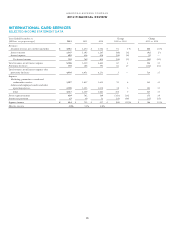American Express 2012 Annual Report Download - page 37
Download and view the complete annual report
Please find page 37 of the 2012 American Express annual report below. You can navigate through the pages in the report by either clicking on the pages listed below, or by using the keyword search tool below to find specific information within the annual report.
AMERICAN EXPRESS COMPANY
2012 FINANCIAL REVIEW
The Company considers various factors in determining the
amount of liquidity it maintains, such as economic and financial
market conditions, seasonality in business operations, growth in
its businesses, potential acquisitions or dispositions, the cost and
availability of alternative liquidity sources, and regulatory and
credit rating agency considerations.
The yield the Company receives on its cash and readily
marketable securities is, generally, less than the interest expense
on the sources of funding for these balances. Thus, the Company
incurs substantial net interest costs on these amounts.
The level of net interest costs will be dependent on the size of
the Company’s cash and readily marketable securities holdings,
as well as the difference between its cost of funding these
amounts and their investment yields. Refer also to “Business
Segment Results — Corporate & Other.”
Securitized Borrowing Capacity
On August 3, 2012, the Company extended its $3.0 billion
committed, revolving, secured financing facility, with an original
maturity date in December 2013, to July 15, 2014. This secured
financing facility gives the Company the right to sell up to $3.0
billion face amount of eligible AAA notes from the Charge Trust.
On October 3, 2012, the Company entered into a new three-
year committed, revolving, secured financing facility maturing
on September 15, 2015 that gives the Company the right to sell
up to $2.0 billion face amount of eligible AAA certificates from
the Lending Trust at any time. Both facilities are used in the
ordinary course of business to fund seasonal working capital
needs, as well as to further enhance the Company’s contingent
funding resources. As of December 31, 2012, $3.0 billion was
drawn on the Charge Trust facility and no amounts were drawn
on the Lending Trust facility.
Federal Reserve Discount Window
As insured depository institutions, the Banks may borrow from
the Federal Reserve Bank of San Francisco, subject to the amount
of qualifying collateral that they may pledge. The Federal Reserve
has indicated that both credit and charge card receivables are a
form of qualifying collateral for secured borrowings made
through the discount window. Whether specific assets will be
considered qualifying collateral and the amount that may be
borrowed against the collateral, remain at the discretion of the
Federal Reserve.
The Company had approximately $44.2 billion as of
December 31, 2012 in U.S. credit card loans and charge card
receivables that could be sold over time through its existing
securitization trusts, or pledged in return for secured borrowings
to provide further liquidity, subject in each case to applicable
market conditions and eligibility criteria.
Committed Bank Credit Facilities
In addition to the secured financing facilities described above,
the Company maintained committed syndicated bank credit
facilities as of December 31, 2012 of $7.7 billion which expires as
follows:
(Billions)
2014 $ 2.1
2015 3.0
2016 2.6
Total $ 7.7
The availability of the credit lines is subject to the Company’s
compliance with certain financial covenants, principally the
maintenance by Credco of a certain ratio of combined earnings
and fixed charges to fixed charges. As of December 31, 2012, the
Company was in compliance with each of its covenants. The
drawn balance of the committed credit facilities of $4.7 billion as
of December 31, 2012 was used to fund the Company’s business
activities in the normal course. The remaining capacity of the
facilities mainly served to further enhance the Company’s
contingent funding resources.
The Company’s committed bank credit facilities do not
contain material adverse change clauses, which might otherwise
preclude borrowing under the credit facilities, nor are they
dependent on the Company’s credit rating.
OFF-BALANCE SHEET ARRANGEMENTS
AND CONTRACTUAL OBLIGATIONS
The Company has identified both on and off-balance sheet
transactions, arrangements, obligations and other relationships
that may have a material current or future effect on its financial
condition, changes in financial condition, results of operations,
or liquidity and capital resources.
35
























